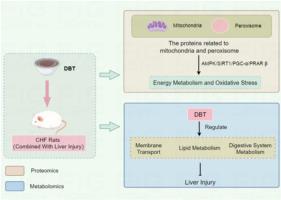Explore the action mechanism of Danggui Buxue decoction on chronic heart failure in rats by proteomics and untargeted metabolomics
IF 3
3区 医学
Q1 INTEGRATIVE & COMPLEMENTARY MEDICINE
Journal of Traditional and Complementary Medicine
Pub Date : 2025-10-01
DOI:10.1016/j.jtcme.2024.08.007
引用次数: 0
Abstract
Background and aim
Danggui Buxue Decoction (DBD) has been applied to alleviate chronic heart failure (CHF) in clinics, however, its mechanism is still unclear. This study investigates the potential action mechanism of DBD for rats with CHF combined with liver injury.
Experimental procedure
For this purpose, this study established a CHF rat model. The change of proteins in myocardial tissues was identified by proteomics and then further verified using western blotting. Additionally, metabolomics revealed the metabolic pathways associated with liver injury in CHF rats.
Results and conclusion
Animal studies demonstrated that DBD could relieve CHF as it significantly reduced serum levels of brain natriuretic peptide (BNP), aspartate aminotransferase (AST), and alanine aminotransferase (ALT) in CHF rats, and promoted the activity of catalase (CAT), glutathione peroxidase (GSH-Px), cytochrome oxidase (COX), and succinate dehydrogenase (SDH) in myocardial tissues. Myocardial proteomics analysis revealed that DBD improved myocardial mitochondria and peroxisomes function by regulating the expression of proteins associated with energy metabolism and oxidative damage. Western blotting confirmed that DBD upregulated the expression of proteins in the adenosine 5′-monophosphate (AMP)-activated protein kinase (AMPK)/silent mating type information regulation 2 homolog-1 (SIRT1)/peroxisome proliferator-activated receptor gamma coactivator 1 alpha (PGC-1 α)/peroxisome proliferator-activated receptor beta (PPAR β) signaling pathway, which also proved the efficacy of DBD in alleviating CHF in rats. Hepatic metabolomics analysis showed that DBD could restore the damaged liver function of CHF rats via metabolic pathways, including the metabolism of lipid, vitamin, and amino acids. In conclusion, this study unveiled a novel action mechanism of DBD in the treating ISO-induced CHF and liver injury based on proteomics and metabolomics. These results lay a scientific basis for the widespread application of DBD in the cardiovascular field.

通过蛋白质组学和非靶向代谢组学方法探讨当归补血汤对大鼠慢性心力衰竭的作用机制
背景和目的当归补血汤(DBD)已被应用于临床治疗慢性心力衰竭(CHF),但其作用机制尚不清楚。本研究探讨DBD对CHF合并肝损伤大鼠的潜在作用机制。为此,本研究建立CHF大鼠模型。用蛋白质组学方法鉴定心肌组织蛋白的变化,再用western blotting进一步验证。此外,代谢组学揭示了与CHF大鼠肝损伤相关的代谢途径。结果和结论DBD可显著降低CHF大鼠血清脑钠肽(BNP)、谷草转氨酶(AST)、丙氨酸转氨酶(ALT)水平,提高心肌组织过氧化氢酶(CAT)、谷胱甘肽过氧化物酶(GSH-Px)、细胞色素氧化酶(COX)、琥珀酸脱氢酶(SDH)活性,具有缓解CHF的作用。心肌蛋白质组学分析显示,DBD通过调节与能量代谢和氧化损伤相关的蛋白质表达,改善心肌线粒体和过氧化物酶体功能。Western blotting证实,DBD可上调腺苷5′-单磷酸腺苷(AMP)活化蛋白激酶(AMPK)/沉默交配型信息调控2同源物-1 (SIRT1)/过氧化物酶体增殖物激活受体γ辅助激活因子1 α (PGC-1 α)/过氧化物酶体增殖物激活受体β (PPAR β)信号通路中蛋白的表达,也证实了DBD对大鼠CHF的缓解作用。肝脏代谢组学分析显示,DBD可通过脂质代谢、维生素代谢、氨基酸代谢等代谢途径恢复CHF大鼠受损的肝功能。综上所述,本研究基于蛋白质组学和代谢组学揭示了DBD治疗iso诱导的CHF和肝损伤的新作用机制。这些结果为DBD在心血管领域的广泛应用奠定了科学基础。
本文章由计算机程序翻译,如有差异,请以英文原文为准。
求助全文
约1分钟内获得全文
求助全文
来源期刊

Journal of Traditional and Complementary Medicine
Medicine-Complementary and Alternative Medicine
CiteScore
9.30
自引率
6.70%
发文量
78
审稿时长
66 days
期刊介绍:
eJTCM is committed to publish research providing the biological and clinical grounds for using Traditional and Complementary Medical treatments as well as studies that demonstrate the pathophysiological and molecular/biochemical bases supporting the effectiveness of such treatments. Review articles are by invitation only.
eJTCM is receiving an increasing amount of submission, and we need to adopt more stringent criteria to select the articles that can be considered for peer review. Note that eJTCM is striving to increase the quality and medical relevance of the publications.
 求助内容:
求助内容: 应助结果提醒方式:
应助结果提醒方式:


